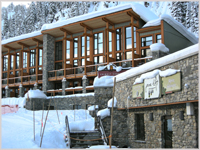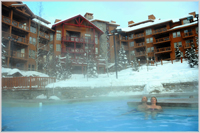 Skiers and snowboarders of all ages expect to succumb to some kind of injury eventually whether from a collision or just too much wear and tear. Surgery is usually the only option and the question on everyone’s mind is: how soon will I be back on the slopes?
Skiers and snowboarders of all ages expect to succumb to some kind of injury eventually whether from a collision or just too much wear and tear. Surgery is usually the only option and the question on everyone’s mind is: how soon will I be back on the slopes?
One of the most vulnerable parts of our body is the knee where damage becomes more likely as we age. Fortunately it’s not the end of the wintersports world these days when we have to have knee surgery. Arthroscopies can be a skier’s best friend, identifying meniscus and cartilage problems before arthritis gets the chance to set in. This can help give us more skiing longevity.
Having had surgery myself for meniscus and cartilage decimation in late August, I decided to investigate how quickly an over-50 skier can get back onto the bumps and pound the powder. The plan: follow the surgeon and physio’s advice to the letter for three months and then see if I can ski. The outcome: ten days of sublime skiing in Canada over Christmas and New Year when I was grateful for every tantalizing turn.
 Put this into perspective: it wasn’t ten straight days. Taking days off is the new reality for the 50-something skier and I spread my ten days over an 18-day vacation. I had been in denial about rest days right up until I overtaxed my knee last February in Vail, Colorado. It was nothing to do with Vail: the snow was fabulous, powder in the glades, the resort vast and no crowds. I didn’t crash, I just spent seven days straight on the slopes, one of which was in the company of a local skier nearly 30 years my junior. With four months altitude acclimatization, ski fitness and youthful stamina in her favour, the only place I managed to outlast her was at the Bully Ranch bar in the Sonnenalp.
Put this into perspective: it wasn’t ten straight days. Taking days off is the new reality for the 50-something skier and I spread my ten days over an 18-day vacation. I had been in denial about rest days right up until I overtaxed my knee last February in Vail, Colorado. It was nothing to do with Vail: the snow was fabulous, powder in the glades, the resort vast and no crowds. I didn’t crash, I just spent seven days straight on the slopes, one of which was in the company of a local skier nearly 30 years my junior. With four months altitude acclimatization, ski fitness and youthful stamina in her favour, the only place I managed to outlast her was at the Bully Ranch bar in the Sonnenalp.
I then spent several wasted months toying with the prospect of surgery while trying to heal myself with exercise and rest. Trust me, self-help doesn’t work and I would have been much better off had I opted for surgery right away.
For rehabilitation onto snow, I chose Canada for its early snow records and the probability of fewer crowds over the peak period. My first tentative turns were at Lake Louise where I was overjoyed to find I could still ski – and not just on my good leg! What I discovered was that my newly-scoped knee craved powder! Or, at the very least, it needed what I christened pow-duroy: a layer of soft overnight snow on top of grooming. This soft surface facilitated a smooth, balletic skiing style, with no juddering vibrations or topographical surprises. Although I managed to get up the Summit Poma and ski the back bowls a little, I favoured Larch Mountain where the snow was soft and the runs less gnarly for the knee.
I’d had some great pre-ski pointers from Dr Delia Roberts, Instructor in Biology, Anatomy and Physiology at Selkirk College. “It is extremely important to work with a qualified physio during rehab,” Dr Roberts counseled. I was vigilant in following her formula for stability, balance and posture exercises, stretching and icing.
 Roberts’ on slope regime for me was 1) warm up, 2) selective skiing, 3) hot tub, 4) stretch, 5) massage, and 6) ice. To make this easier to achieve, I planned a “staycation” at Lake Louise, Sunshine, Kimberley and Panorama with travel days doubling up as rest days.
Roberts’ on slope regime for me was 1) warm up, 2) selective skiing, 3) hot tub, 4) stretch, 5) massage, and 6) ice. To make this easier to achieve, I planned a “staycation” at Lake Louise, Sunshine, Kimberley and Panorama with travel days doubling up as rest days.
“At the first sign of pain and fatigue back off,” Roberts had said. “Build it up slowly.” So, I inched up my speed and gradient in baby steps, gradually progressing to more adventurous runs, cruising the carefree corduroy on the groomers and shopping for gentler bumps at the edges of black runs.
Following Roberts’ regime, I did ten minutes warm-up before skiing and après-ski stretching at the Lake Louise Inn exercise room. I soaked my knotty muscles in the poolside hot tub just opposite my easy-access ground-floor suite. The hotel’s free door-to-door shuttle helped conserve my energy and strength for the main game. An unexpected bonus courtesy of my injury was a pine marten sighting, right on my patio bordering the forest. It had come to investigate my ice-pack (a re-commissioned Safeway bag full of snow) which I had left outside overnight.
Moving on to Sunshine Village, where over three metres of snow had already fallen by mid-December, I ventured into the trees and onto baby bumps. By my fourth day of skiing I was back into the black chutes and even dared a double diamond, albeit slowly with lots of rest. Still, one of my favourites was the blue Sunshine Coast on Goat’s Eye where I kept finding untouched pow-duroy to play in.
 One of the Sunshine Mountain Lodge’s best attributes for my knee rehab was the wonderful outdoor hot tub under the stars where I rested after doing my physical therapy exercises in the adjoining gym. I found that these daily stretches were absolutely essential to fuel my flexibility.
One of the Sunshine Mountain Lodge’s best attributes for my knee rehab was the wonderful outdoor hot tub under the stars where I rested after doing my physical therapy exercises in the adjoining gym. I found that these daily stretches were absolutely essential to fuel my flexibility.
Trickle Creek Lodge in Kimberley was next on the itinerary, another perfect piste-side venue for post-surgery ski in/out conveniences. Right on the slopes, there are no steps to negotiate or tiring trudges to lifts. As well as an exercise room, there are great outdoor hot pools surrounded by hot tubs. Even during the busy holiday season, line-ups are light and gladed runs such as Flush and Comet are not crowded. And, as knee problems don’t impinge on après-ski, the cheese fondue at the Old Bauernhaus was a great holiday enhancer.
Next was pampering: my ski safari culminated at Panorama where I had promised myself number 5 on Roberts’ list – massage. Up until this point I had contrived this myself with “The Stick” – a segmented rolling-pin contraption for easing taut muscles. But at Pure Massage – in the Pine Inn just below the Mile 1 Quad – I got the real thing courtesy of physical therapist, Genevieve Verge. I discovered that nothing can beat a professional massage for IT bands, quads and calves after skiing.
 The team of therapists here works closely with Panorama’s resident physiotherapist, Catrien De Ruyter who had recommended The Stick to me. De Ruyter includes massage in her knee rehab programs for recreational skiers as well as the ski workers and professionals she treats. “I see lots of knee injuries, over half of those are meniscus problems, and ski racers have lots of ACL issues,” she says. Working with race development teams from all over the world, De Ruyter gets skiers back on the slopes swiftly but with sound education. After assessment, she offers adjustments, exercise programs, ultra-sound, compression/ice treatment as well as healthy eating, hydration and weight loss plans to reduce load on knees.
The team of therapists here works closely with Panorama’s resident physiotherapist, Catrien De Ruyter who had recommended The Stick to me. De Ruyter includes massage in her knee rehab programs for recreational skiers as well as the ski workers and professionals she treats. “I see lots of knee injuries, over half of those are meniscus problems, and ski racers have lots of ACL issues,” she says. Working with race development teams from all over the world, De Ruyter gets skiers back on the slopes swiftly but with sound education. After assessment, she offers adjustments, exercise programs, ultra-sound, compression/ice treatment as well as healthy eating, hydration and weight loss plans to reduce load on knees.
After 10 days skiing (over the 18 day vacation), some aches and pains had revived in my knee, which De Ruyter ascribed to bone bruising from surgery coupled with the vibrations cause by skiing. She recommended a rigid return to rest, ice and exercises, giving at least two weeks for the soft tissue to settle before skiing again. I’ve actually left it six weeks before skiing again and I’m just starting to pack for my next ski trip; this time to Aspen Snowmass, Colorado.
For other skiers with burgeoning knee problems, De Ruyter warned that years of grinding debris in the knee leads to arthritis. Her verdict on knee surgery: “It’s common, it’s not the end of the world”. And my own conclusion – surgery is definitely not the “knee” all and end all for your ski career!
Read more of Louise's ski articles at www.onetwoski.blogspot.com











